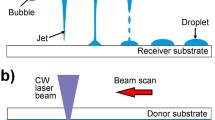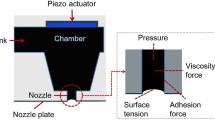Abstract
An axisymmetric thermo-mechanical model is developed for laser-driven non-contact transfer printing, which involves laser-induced impulsive heating to initiate separation at the interface between a soft, elastomeric stamp and hard micro/nanomaterials (i.e., inks) on its surface, due to a large mismatch in coefficients of thermal expansion. The result is the active ejection of the inks from the stamp, to a spatially separated receiving substrate, thereby representing the printing step. The model gives analytically the temperature field, and also a scaling law for the energy release rate for delamination at the interface between the stamp and an ink in the form of a rigid plate. The normalized critical laser pulse time for interfacial delamination depends only on the normalized absorbed laser power and width of the ink structure, and has been verified by experiments.
Similar content being viewed by others
References
Campbell SA (2001) The science and engineering of microelectronic fabrication. Oxford University Press, New York
Crawford GP (2005) Flexible flat panel display technology. Wiley, New York
Dassault Systèmes (2009) ABAQUS Analysis User’s Manual V6.9. Pawtucket
Fettis HE, Caslin JC, Cramer KR (1973) Complex zeros of the error function and of the complementary error function. Math Comput 27: 401–407
Forrest SR (2004) The path to ubiquitous and low-cost organic electronic appliances on plastic. Nature 428: 911–918
Gelinck GH, Huitema HEA, Van Veenendaal E et al (2004) Flexible active-matrix displays and shift registers based on solution-processed organic transistors. Nat Mater 3: 106–110
Incropera FP, DeWitt DP, Bergman TL et al (2007) Fundamentals of heat and mass transfer. Wiley, Hoboken
Kim DH, Ahn JH, Choi WM et al (2008) Stretchable and foldable silicon integrated circuits. Science 320: 507– 511
Kim DH, Lu NS, Ghaffari R et al (2011) Materials for multifunctional balloon catheters with capabilities in cardiac electrophysiological mapping and ablation therapy. Nat Mater 10: 316–323
Kim DH, Lu NS, Ma R et al (2011) Epidermal electronics. Science 333: 838–843
Kim DH, Viventi J, Amsden JJ et al (2010) Dissolvable films of silk fibroin for ultrathin conformal bio-integrated electronics. Nat Mater 9: 511–517
Kim RH, Kim DH, Xiao JL et al (2010) Waterproof AlInGaP optoelectronics on stretchable substrates with applications in biomedicine and robotics. Nat Mater 9: 929–937
Ko HC, Stoykovich MP, Song JZ et al (2008) A hemispherical electronic eye camera based on compressible silicon optoelectronics. Nature 454: 748–753
Li R, Li Y, Lü C et al (2012) Thermo-mechanical modeling of laser-driven non-contact transfer printing: two-dimensional analysis. Soft Matter 8: 3122–3127
Lu NS, Yoon J, Suo ZG (2007) Delamination of stiff islands patterned on stretchable substrates. Int J Mater Res 98: 717–722
Lumelsky VJ, Shur MS, Wagner S (2001) Sensitive skin. Sens J IEEE 1: 41–51
Mannsfeld SCB, Tee BCK, Stoltenberg RM et al (2010) Highly sensitive flexible pressure sensors with microstructured rubber dielectric layers. Nat Mater 9: 859–864
Mark JE (1999) Polymer data handbook. Oxford University Press, New York
Meitl MA, Zhu ZT, Kumar V et al (2006) Transfer printing by kinetic control of adhesion to an elastomeric stamp. Nat Mater 5: 33–38
Nathan A, Park B, Sazonov A et al (2000) Amorphous silicon detector and thin film transistor technology for large-area imaging of X-rays. Microelectron J 31: 883–891
Okada Y, Tokumaru Y (1984) Precise determination of lattice-parameter and thermal-expansion coefficient of silicon between 300-K and 1500-K. J Appl Phys 56: 314–320
Saeidpourazar R, Li R, Li Y et al (2012) Laser-driven micro-transfer placement of prefabricated microstructures. J Microelectromech Syst. doi:10.1109/JMEMS.2012.2203097
Sekitani T, Nakajima H, Maeda H et al (2009) Stretchable active-matrix organic light-emitting diode display using printable elastic conductors. Nat Mater 8: 494–499
Sekitani T, Zschieschang U, Klauk H et al (2010) Flexible organic transistors and circuits with extreme bending stability. Nat Mater 9: 1015–1022
Someya T, Kato Y, Sekitani T et al (2005) Conformable, flexible, large-area networks of pressure and thermal sensors with organic transistor active matrixes. Proc Natl Acad Sci USA 102: 12321–12325
Someya T, Sekitani T (2009) Printed skin-like large-area flexible sensors and actuators. Proc Eurosens Xxiii Conf 1: 9–12
Someya T, Sekitani T, Iba S et al (2004) A large-area, flexible pressure sensor matrix with organic field-effect transistors for artificial skin applications. Proc Natl Acad Sci USA 101: 9966–9970
Suo ZG (1989) Singularities interacting with interfaces and cracks. Int J Solids Struct 25: 1133–1142
Viventi J, Kim DH, Moss JD et al (2010) A conformal, bio-interfaced class of silicon electronics for mapping cardiac electrophysiology. Sci Transl Med 2:24ra22
Viventi J, Kim DH, Vigeland L et al (2011) Flexible, foldable, actively multiplexed, high-density electrode array for mapping brain activity in vivo. Nat Neurosci 14: 1599–1605
Yoon J, Baca AJ, Park SI et al (2008) Ultrathin silicon solar microcells for semitransparent, mechanically flexible and microconcentrator module designs. Nat Mater 7: 907–915
Author information
Authors and Affiliations
Corresponding author
Additional information
Rui Li and Yuhang Li contributed equally to this work.
Rights and permissions
About this article
Cite this article
Li, R., Li, Y., Lü, C. et al. Axisymmetric thermo-mechanical analysis of laser-driven non-contact transfer printing. Int J Fract 176, 189–194 (2012). https://doi.org/10.1007/s10704-012-9744-9
Received:
Accepted:
Published:
Issue Date:
DOI: https://doi.org/10.1007/s10704-012-9744-9




